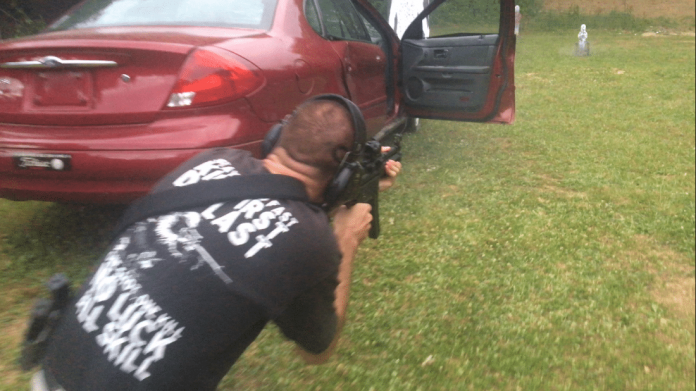
Locate.
Close.
Destroy.
These are the focus words of the Mission of the Marine Corps Rifle Squad. To locate, close with, and destroy the enemy by fire and maneuver.
These words were my formal introduction to gunfighting.
They have no bearing on use of force as a concealed or defensive carrier. Defensive carry has one goal and that is to keep you alive.
Run.
Hide.
Fight.
These are defensive focus words. Anyone packing a pistol or any alternative defensive tool needs a defensive mindset loaded with them too.
The shift in mindset from the infantry squad to the individual or small group defense is based on two critical factors, mission and legality. These two factors are linked but have individual aspects we will address.
Mission
Unless you are an infantry squad on a contact patrol actively hunting a fight with enemy ground forces you are not on the offense. Concealed carry is a defensive mission. Law enforcement response, even active shooter response is a defensive mission. The objective is preservation of life, yours and others.
Mission objective doesn’t change how you apply violence (swift, sudden, and overwhelming) but it sets your trigger criteria for becoming violent.
As a defensive carrier you are going kinetic when it is immediately necessary in order to extract yourself and those under your care from a lethal threat. You are not hunting an active engagement. That is someone else’s job and your involvement can cause that to become infinitely more complicated.
Legality
Tied to mission, legality is the list of written legal permissions and obligations you possess for your mission. You need to be critically observant of these. They will make or break whether or not you will be subject to legal penalty for your actions.
Even troops deployed overseas in combat must observe concern for the legality of their engagements.
A defensive carrier must be, at all times, within the bounds of the law regarding their use of force and any action that pulls use of force into question increases your legal risk. This usually accompanies an increase in physical risk which is directly contrary to your mission of staying alive.
So Run. Hide. Fight.
The prompt for this article was commentary on a corporate active shooter course. Most are a joke that pay lip service to the ideas while giving little to nothing in actual training. The courses are checks in boxes on business to do lists that make HR, Safety, and Liability offices happy.
The theory itself is sound. It just needs to be seriously addressed.
Run
If a violent threat presents itself in your vicinity and you are able to evacuate yourself, do do. If someone or someones are running people down with a truck in the market, leave the market.
If someone or ones are entering a building and shooting people then the nearest exit followed by distance is your safest option.
Getting yourself off of the X and out of the area of immediate threat should be your priority. If you can do the same for others, excellent. Be constantly aware of whether or not your actions are increasing your own likelihood of becoming a causality.
Hide
If distance from the threat can’t be gained safely staying out of sight and using barriers as cover and concealment is your next tactic. Use any object in your environment that offers you advantage.
Thick dense objects offer greater protection from gunfire while any object of sufficient size can hide your and others presence. If the threat is seeking targets of opportunity its likely they will move on if they don’t see any.
Keep in mind while hiding that you may need to switch quickly to either Run or Fight. These three aspects of defensive tactics are constantly inter-working. They are not mutually exclusive.
While concealed, picking points that will be advantageous to ambush the threat and gain a violent advantage is a parallel observation and process to picking an expedient escape route and staying out of sight. Remain flexible, choose quickly, act, react.
Fight
The moment both Run and Hide become lethally high risk then its time to fight. These decisions and transitions will need to be made as decisively as they are rapidly.
When you fight, FIGHT!
The threat must be swiftly engaged and the ability for the threat to continue acting effectively must be destroyed. At minimum hostile action must be disrupted for enough time to extract yourself from danger.
Conventionally or unconventionally armed is irrelevant beyond how you’re delivering damage. Plan a swift, sudden, and overwhelming engagement.
Swift – When you move, move fast, you don’t have a sneak skill and speed will trump perceived stealth.
Sudden – Ambush the threat. Greater distance is your friend while evading but closer distances are your advantage engaging. Let a threat close as much distance as you can before your attack, the closer you are the more time you take away from their reaction. Use an off angle if possible, threats can react quickest head on.
Overwhelming – Like stated above your mission now is to destroy the threats ability to continue being a threat. Shoot them, stab them, strike vulnerable areas, use objects of advantage. Cause trauma to a level that is irrecoverable, at least short term, so that you can now assert control or escape.
As for injury? The situation you find yourself in already presents near imminent threat of harm and death so what do you have to lose? Don’t be the paralyzed individual who says to the news later “I couldn’t do anything because they were right next to me.”
So Run, Hide, Fight. When you fight, destroy. When the fight is won, Control and/or escape.
Simple enough?



